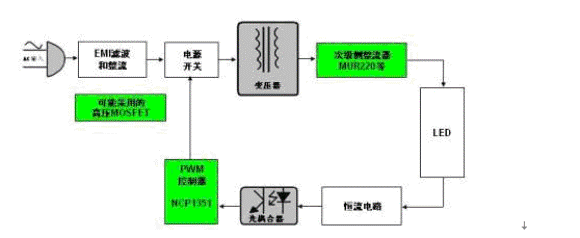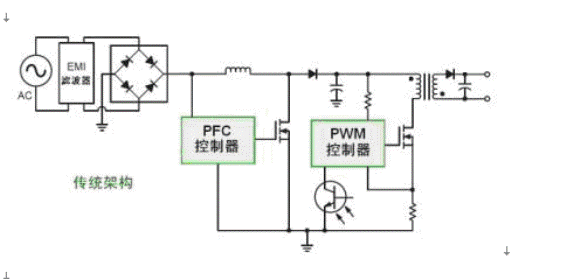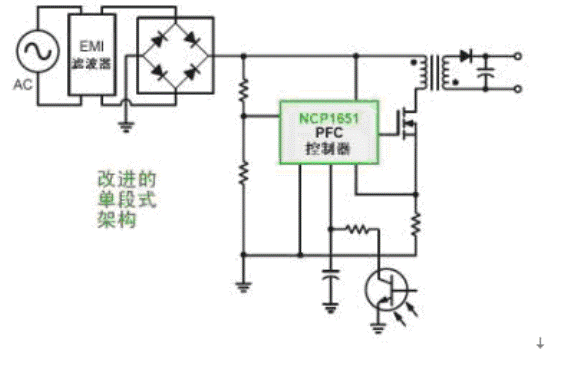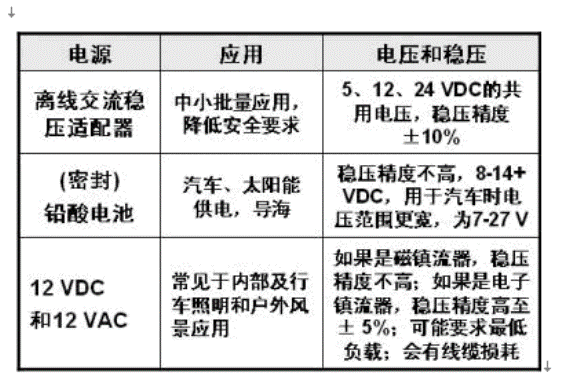ON Semiconductor's complete LED power solution
Central issue:
This article refers to the address: http://
LED applications continue to expand, requiring power solutions to support
Ansonmei LED Application Power Solution Introduction
solution:
Power Solutions for LED Lighting Applications
LED portable backlight application power solution
Compared with traditional light sources, light-emitting diodes (LEDs) have many advantages, such as low operating voltage, high energy efficiency, small size and directional light. They offer extremely wide color and white light, do not produce infrared (IR) or ultraviolet (UV) radiation, and because they are solid-state devices, they are mechanically strong and contain no mercury, and can be designed and used to exceed The working life of 50,000 hours is much longer than the 1,000-hour life of standard incandescent lamps. In addition, they are fully dimmable. These advantages make LED applications more and more widely available, and now have a large number of application markets, such as architectural landscape lighting, traffic lights, display screens, retail, small and medium size liquid crystal display (LCD) backlights, cars and solar energy, etc. There is more and more room for development in lighting, residential lighting and even medium and large LCD backlights.
High-brightness LEDs are of great importance to lighting design, global energy savings, and innovative products, and are critical to the revolution in solid-state lighting. This revolution requires a holistic approach in which LEDs are integrated with power conversion and control electronics as well as thermal management solutions and optics.
Power Solutions for LED Lighting Applications
As mentioned above, LEDs are essentially low voltage devices; depending on color and current, the LED's forward voltage is between less than 2 V and 4.5 V. In addition, LEDs need to be driven with a constant current to ensure the desired brightness and color. This requires a corresponding power conversion and control solution to accommodate different power sources, whether AC lines, solar panels, 12 V car batteries, DC power supplies or low voltage AC systems, or even alkaline and nickel based batteries or lithium ion batteries.
As a leading global provider of energy-efficient power semiconductors, ON Semiconductor is focused on addressing the challenges of LED lighting with its low-voltage and high-voltage technologies and expertise in power management solutions: from portable display products to Ballast for automotive interior lighting or LED signal lights. In the following, we will discuss the corresponding drive power solutions from ON Semiconductor in combination with a variety of different applications for LED lighting, such as architectural, industrial, automotive and portable applications.
1) Off-line AC-DC switching power supply solution that can integrate up to 700 V high voltage FET

Figure 1(a): Functional block diagram of an LED lighting solution with input power less than 10 W
ON Semiconductor has extensive experience in converting power from AC mains to power levels ranging from a few watts to hundreds of watts, making it suitable for a wide range of applications. ON Semiconductor has developed a Very High Voltage Integrated Circuit (VHVIC) that combines high voltage switching transistors with medium voltage analog circuits to provide an integrated cost effective solution for a wide range of power requirements. ON Semiconductor offers a wide range of fixed frequency controllers and converters that integrate high voltage FETs up to 700 V into a simple, economical, low component count solution.
This type of solution includes three aspects: a single-chip AC-DC constant current driver with a power range of 5 to 15 W, such as NCP1013, NCP1014, and NCP1028. The NCP series of off-line controllers, both isolated and non-isolated, can be powered up to 150 W. ON Semiconductor offers reference designs for street lighting with a single-stage power factor corrector (PFC).

Figure 1(b): Functional block diagram of an LED lighting solution with input power between 10 and 25 W
PFC solution
For lower power applications with power below 25 W (230 Vac), the most common is the integrated power switching regulator because it minimizes component count. Above this power range, the controller can be used because the controller provides designers with the flexibility to choose the most suitable high voltage FET for this application. Controllers can be used for both isolated and non-isolated applications, and ON Semiconductor offers a variety of value-added features that allow designers to optimize designs for their specific design requirements.

Figure 2: NCP1351 Offline LED Driver Reference Design.
Figure 2 shows the ON Semiconductor NCP1351 offline LED driver reference design. The reference design's input power range is between 85 and 265 Vac, featuring small size, low cost, good line regulation, 80% energy efficiency at 20 W load, and integrated overload protection and short circuit protection. Safety features, the maximum size is only 125 × 37 × 35 mm.

Figure 3 (a): The traditional 2-stage PFC architecture.
The IEC1000-3-2 standard sets specifications for limiting the harmonics injected into the AC line. For lighting applications, this specification applies if the input power is greater than 25 W (Class C). In addition, even in some areas it is not required to comply with this IEC specification, and the minimum power factor may be required. As a result, front-end PFC controllers are required in these applications. Adding such a segment can lead to difficulties in meeting other system requirements such as energy efficiency and space, unless an informed choice is made.

Figure 3(b): Improved single-segment PFC architecture.
Fortunately, ON Semiconductor understands these challenges and has an innovative lineup of PFC controllers that meets designers' expectations for simple, compact and rugged solutions. Not only does ON Semiconductor support traditional 2-stage applications, but it also introduces several unique solutions that further simplify the design, such as the NCP1651 single-stage flyback controller.
The NCP1651 integrates power factor correction and converters in a single-chip solution with external FETs, allowing a scalable solution based on required power. The NCP1651 features an isolated buck function that supports continuous or discontinuous mode operation and supports average current mode control (ACMC) and fixed frequency control with high precision multipliers to reduce overall harmonic distortion (THD). It also has features such as over temperature shutdown and external shutdown. This single-stage PFC controller is ideal for applications such as electronic ballasts, street lights, traffic lights and lighting.
For LED lighting applications with input power between 25 W and 60 W, a PWM controller such as the NCP1351 can be used; for input powers ranging from 60 W to 150 W, the PWM controller can be NCP1271; input power In the 150 W to 300 W range, a PWM controller such as the NCP1396 can be used. For the input power range of 25 W to 300 W, the critical conduction mode (CRM) PFC controller NCP1606 can be used.
2) Medium voltage LED application DC-DC power solution with wide input range
In addition to portable power applications, there is a range of high-brightness LED applications operating in the 8 to 40 VDC range, including lead-acid batteries, 12-36 VDC adapters, solar cells, and low-voltage 12- and 24 VAC AC systems. There are many lighting applications of this type, such as mobile lighting, landscape and road lighting, automotive and traffic lighting, solar powered lighting, and showcase lighting.

Table 1: Wide Input Range DC-DC LED Applications
Even if the goal is to drive the LED with a constant current, the first thing to understand is the application's input and output voltage variations. The forward voltage of the LED is determined by material properties, junction temperature range, drive current, and manufacturing tolerance. With this information, you can choose the right linear or switching power supply topology, such as linear, buck, boost, or buck-boost.
For LED applications with input voltages less than 40 V, the buck topology is selected if the output voltage is less than the input voltage. Based on this, the selection is based on the output current. If the output current is greater than 1.2 A, a 1.5 A constant current switching regulator NCP3065 designed to power high brightness LEDs can be used. The device has a very low feedback voltage rating of 235 mV and is suitable for stabilizing the average current of the LED string. It has a wide input voltage range of up to 40 V, enabling it to operate from a 12 Vac or 12 Vdc supply. The NCP3065 also offers a version for the automotive grade application - NCV3065. With minimal external components such as MOSFETs or low VCEsat switches, the NCP3065 switching regulator can be configured in buck, boost or SEPIC topologies. This makes it suitable for applications with currents less than 1.2 A. For applications with currents less than 1.2 A, the NCP1215+ MOSFET can also be used to form a buck converter. For applications where the current is less than 500 mA and the input voltage is close to the output voltage, a constant current linear driver such as the NUD4001 can be used.
If the output voltage is greater than the input voltage, select the boost topology. On this basis, if it is a low-voltage battery-powered application, you can use low-voltage LED drivers such as NCP5005, NCP5604, NCP5608, and NCP5050; if it is not a low-voltage battery-powered application, look at its output voltage value. If it is greater than 40 V, it can also be used. NCP3065 switching regulator, this time NCP3065 combined with external NMOS MOSFET configuration as a boost controller structure; otherwise, depending on the switching current to determine. If the switch current is greater than 1.3 A, use the NCP3065 with a MOSFET or low VCEsat switch configured as a boost controller; if less than 1.3 A, use the NCP3065 configured as a boost converter.
In addition to a simple buck or boost topology, in some environments, a buck-boost topology is required, such as driving a LED string from a standard power input; in addition, where the input voltage and LED load voltage overlap It is also common to use this topology. The NCP3065 can also be configured as a buck-boost controller. This architecture requires 2 power switches. Although the NCP3065 itself also includes a power switch, we can use a low VCEsat PNP/NPN pair tube for higher conversion efficiency. This is a scalable solution where the rectifier and power switch can be adjusted to the specific input and output voltages and current levels. It is worth mentioning that low VCEsat transistors such as the NSS40500UW3 offer excellent performance in a small 2 x 2 mm package.
Figure 4 shows the NCP3065 buck-boost circuit with up to 12 W. This circuit is designed for applications up to 0.7 A with an input voltage range of 8 to 26 Vdc. When the output voltage Vout is 16 Vdc @ 700 mA and the input voltage Vin is 13-26 Vdc, the energy efficiency can reach 72% to 80%.

Figure 4: NCP3065 Buck-Boost Circuit with Power Up to 12 W
LED portable backlight application power solution
White LEDs and RGB tri-color LEDs are widely used in backlighting and indicator applications for small LCD panels and keyboards. In mobile phones and digital camera applications, high-brightness LEDs can also be used as flash power supplies. These applications require an optimized solution that not only maximizes battery life, but also minimizes PCB footprint and height.
In this type of LED backlight application, either a linear regulator or a switching regulator can be used, each with its advantages. The linear regulator has a simple structure, simple design, low cost, low noise, small size, and low quiescent current. The switching regulator has a high energy efficiency of 70 to 85%. ON Semiconductor offers a wide range of solutions based on the user's application needs. In terms of switching regulator solutions, both inductive and charge pump types are available. Specifically, the inductive boost drivers NCP5005 and NCP5050 have the advantages of high energy efficiency and high output voltage, and their energy efficiency is over 90%, and most of them can drive up to 5 LEDs in series (output voltage up to 21 V). In addition, this type of device also has ideal illumination/current matching characteristics due to the series connection of LEDs. With no inductors required, the charge pump drivers NCP5602, NCP5612, and NCP5623 help create a compact, compact solution that is important for portable products with small LCD sizes. This type of driver is equipped with low cost capacitors and resistors to create a lower cost solution. This driver can drive 1 to 3 LEDs and is suitable for backlighting applications in small devices.
In addition to LCDs, the emerging display technology of organic light-emitting diodes (OLEDs) has also been used in portable devices and even large-sized flat-panel TVs in recent years. The initial appearance of the market is passive matrix OLED (PMOLED), which has a display size limited to 1.8 inches and below due to its driving topology, and is commonly used in MP3 players and mobile phone sub-screens. The updated Active Matrix OLED (AMOLED) technology has no display size limitations, and it has several important advantages over LCDs, such as wide viewing angle, high contrast, extremely fast response time and slim thickness, thanks to It eliminates the need for backlighting. The AMOLED panel is used for the main display of the mobile phone and an MP3 player.
ON Semiconductor is the first in the market to introduce a dedicated active matrix (AMOLED) panel regulated power supply IC - NCP5810D. The NCP5810D dual output DC-DC converter achieves an energy efficiency of up to 83% over the entire 1.75 MHz oscillator frequency. It has excellent line transient immunity and a line transient voltage of 5 mV at 25 mA. To accommodate the slim profile of the AMOLED display, the converter can be converted to a high frequency of 1.75 MHz, using smaller inductors and ceramic output capacitors. Its 0.55mm thick ultra-thin package makes the NCP5810D suitable for the thinnest portable product design. In addition, its power-off function in shutdown mode limits the leakage display current to 1 microamp, saving battery power in the off state. The NCP5810D also features cycle-by-cycle peak current limiting and thermal shutdown protection. The NCP5810D is available in an ultra-thin 3.0mm x 3.0mm x 0.55mm LLGA-12 package.

Figure 5: Functional block diagram of the ON Semiconductor AMOLED regulated power supply IC NCP5810D.
In addition to LCD backlighting and AMOLED power applications, ON Semiconductor also introduced LED driver ICs for camera flash applications such as the NCP5680. Take the NCP5680 as an example. This is a dual LED flash driver with a supercapacitor that can drive two high-brightness LEDs with 2.5 A or higher. It is controlled by I2C and has a built-in flash sequence. Its sensitizing function saves energy by limiting the flash time in bright environments. This device uses supercapacitors to support other large peak current circuits such as audio, as well as protection against short-circuit protection. The device began mass production in July 2008.

Figure 6: Schematic diagram of the application of ON Semiconductor's supercapacitor LED driver NCP5680.
to sum up
With its many advantages, such as low operating voltage, high energy efficiency, rich colors, directional light, and mercury-free, LED technology is gaining wider and wider applications in the fields of construction, transportation, automotive, solar energy, LCD backlighting, automotive and residential lighting. As the world's leading provider of energy-efficient power solutions, ON Semiconductor offers a broad portfolio of LED driver power solutions for high-voltage off-line AC-DC switching power supplies to medium-voltage LED power supplies with wide input range and portable backlighting and The wide-ranging needs of flash-driven applications and the provision of related reference designs help customers reduce development time and speed time-to-market.

Pay attention to ON Semiconductor's official WeChat to learn more innovative and energy-efficient solutions
We usually use AVSS, AVS, TXL or cable with generally 18AWG or custom gauge to 16AWG or 14AWG.The connector we recommand is Tyco/AMP/Delphi/Bosch/Deutsch/Yazaki/Sumitomo /Molex replacements or originalTo be applied in automobile or motorcycle HID headlight upgrading system.
We can do any extension cable on GPS Tracking Systems & Driving recorder camera. If you need further question, our profeessional engineers are able to solve for you.
Camera Harness,Camera Wire Harness,Electrical Cable Crimper,Wiring Harness Clips
Dongguan YAC Electric Co,. LTD. , https://www.yacenter-cn.com